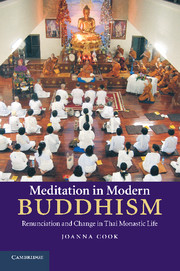Book contents
- Frontmatter
- Contents
- Acknowledgements
- List of map and figures
- Notes on language
- Map 1 Map of Thailand
- 1 Meditation and monasticism: making the ascetic self in Thailand
- 2 Meditation and religious reform
- 3 The monastic community: duty and structure
- 4 Meditation as ethical imperative
- 5 Language and meditation
- 6 Monastic duty, mindfulness and cognitive space
- 7 Money, mae chee and reciprocity
- 8 Hierarchy, gender and mindfulness
- 9 Monasticization and the ascetic interiority of non-self
- Appendix: Ordination transcript for an eight-precept nun (mae chee)
- Bibliography
- Index
8 - Hierarchy, gender and mindfulness
Published online by Cambridge University Press: 03 May 2011
- Frontmatter
- Contents
- Acknowledgements
- List of map and figures
- Notes on language
- Map 1 Map of Thailand
- 1 Meditation and monasticism: making the ascetic self in Thailand
- 2 Meditation and religious reform
- 3 The monastic community: duty and structure
- 4 Meditation as ethical imperative
- 5 Language and meditation
- 6 Monastic duty, mindfulness and cognitive space
- 7 Money, mae chee and reciprocity
- 8 Hierarchy, gender and mindfulness
- 9 Monasticization and the ascetic interiority of non-self
- Appendix: Ordination transcript for an eight-precept nun (mae chee)
- Bibliography
- Index
Summary
As we have seen in the preceding chapters, mae chee are playing qualified roles in emblematic monastic practices and are an integral part of the community in Wat Bonamron. In this chapter I wish to examine the gendered hierarchy of the monastic community in more detail, taking into account prevalent understandings of gender and modernity in Thailand. If monastics are aiming to experience a sense of self as delusional, what implications does this have for the ways in which they relate to each other within a gendered hierarchy?
The ambivalence found in the roles and changing status of mae chee in a meditation monastery presents some interesting dilemmas for the anthropologist. On the one hand, mae chee are being recognized as religious professionals in previously male-defined spheres. They are being accorded considerable respect and prestige. On the other hand, the media through which such change is being enacted (through mae chee embodying moral norms such as humility, equanimity and servitude) engage precisely those idioms that have historically marked and ensured their subordination to male authority. Thus, the performance of the virtues of grace and modesty that are concomitant with being mindful may be understood as an enhancement of the virtues that mark their subordination.
- Type
- Chapter
- Information
- Meditation in Modern BuddhismRenunciation and Change in Thai Monastic Life, pp. 151 - 172Publisher: Cambridge University PressPrint publication year: 2010



